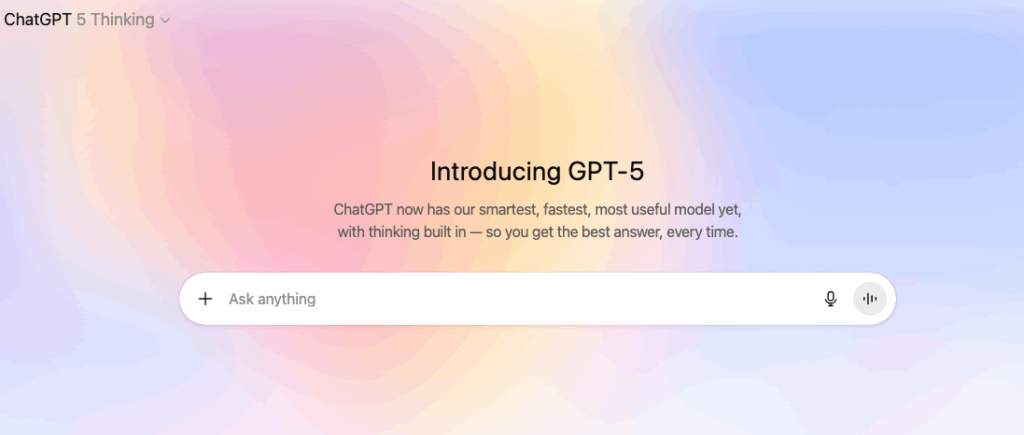OpenAI’s GPT-5 has arrived. Here’s what seems to be different this time.
GPT-5 is OpenAI’s smartest, fastest model yet. Here’s how it decides when to think deeply, what’s new, and what it means for AI’s future.
Some questions deserve an instant answer. Others need a pause, a moment to think and weigh the possibilities. Now here’s the thing – most AI assistants used to treat every prompt the same, firing back as fast as possible unless you specifically instructed them to slow down.
That, according to OpenAI, is what’s changing with GPT-5. In their words, it is the “smartest, fastest, and most useful model yet,” designed to decide how much thinking a question deserves before responding. They also describe it as capable of delivering “expert-level performance” across tasks, from coding to creative work.
So what exactly is GPT-5, and how is it different from the models we’ve been using until now? Let’s understand.

What is GPT-5?
GPT-5 is OpenAI’s newest flagship AI model, released on August 7, 2025, and instantly rolled out to all ChatGPT users.
On the surface, it seems to be the successor to GPT-4o, but OpenAI positions it as much more than a simple upgrade. According to them, it’s the “smartest, fastest, and most useful model yet” that can adjust the level of thinking based on the complexity of request.
In practice, this means GPT-5 might answer a short factual query in seconds. But if your ask is a bit more complicated (say debugging tricky code or walking through a layered analysis), it will slow down, reason through the steps, and deliver a more considered response.
Since this adaptive approach has been built in from the start, users will no longer need to prompt it with “think step by step” or other manual instructions.
Like its predecessors, GPT-5 is multimodal, able to work with text, images, and code. It’s available in several versions, each optimised for different needs:
- GPT-5 Pro – the full-capability model for complex reasoning and creativity.
- GPT-5 Thinking – prioritises deep, step-by-step problem solving for high-stakes or multi-part queries.
- GPT-5 Mini – a lighter, faster model for quick answers and lower-cost API calls.
- GPT-5 Nano – ultra-lightweight for speed-critical or embedded applications.
GPT-5 is available right now inside ChatGPT (free and paid plans) or it can be accessed via the OpenAI API. Developers can also adjust how it works using new settings like verbosity (how detailed its answers are) and reasoning effort (how much thinking time it invests in a response).
How GPT-5 is different from previous models?
With every new release, OpenAI promises better speed, accuracy, and safety. But GPT-5’s biggest shift is less about raw power and more about how it decides to think.
Earlier models, including GPT-4 and GPT-4o, treated most prompts the same way and answered quickly. GPT-5 changes that. It now evaluates the nature of your request and adjusts its approach – moving between rapid responses and more deliberate reasoning when the task calls for it.
This dynamic thinking changes the entire nature of interaction. Instead of being a fixed-output tool, GPT-5 behaves more like a collaborator who knows when to brainstorm fast and when to dig deeper.
OpenAI also claims other notable differences like:
- Improved accuracy – fewer hallucinations and better fact-checking built in.
- Higher benchmark scores – GPT-5 sets new highs on coding, problem-solving, and multi-step reasoning tests.
- Personalisation options – you can choose from preset “personalities” and adjust the detail level of responses.
- Tighter integration – direct connections with tools like Gmail and Google Calendar for contextual replies.
What you can do with GPT-5 today?
You don’t need a special invite or developer account to try GPT 5, and that’s a big part of why this launch matters.
Here are a few ways you could put it to work right now:
#1 – Debug tougher code issues
→ Multi-file bugs, vague error logs, or unfamiliar libraries – GPT-5’s “Thinking” mode is built to break down the problem logically, not just guess a fix.
#2 – Analyse and interpret data
→ Paste in campaign metrics, survey results, or product analytics, and GPT-5 will identify patterns, highlight anomalies, and suggest next steps — without rushing to a generic summary.
#3 – Create small interactive apps from scratch
→ Want to build a mini web tool? According to OpenAI, you can ask GPT‑5 to “create a beautiful, highly interactive web app” in a single HTML file. You can complete with animations, high‑score tracking, and even fun sound effects.
Why GPT-5 works the way it does?
Adaptive reasoning might sound like a technical tweak, but it’s really a shift in how we’ll interact with AI. OpenAI wants the model to feel less like a tool you operate and more like a partner that anticipates your needs.
This sort of signals where the AI race is headed. Google, Anthropic, and others are chasing “thinking” models, and GPT-5 shows OpenAI doesn’t want users to choose between fast or deep answers, it wants the model to decide for them. Whether that’s a step toward AGI or simply better orchestration is still up for debate, but it’s a design choice that will change how people use AI day to day.
Where this leaves us?
Some stories in tech are about numbers and benchmarks. This one’s about something quieter – a shift in how an AI decides to meet you halfway. GPT-5 might not change your world in a single day, but it will slowly change the rhythm of how you ask, think, and get answers.
I’ll be watching for the moments when it gets it wonderfully right, and the moments when it still stumbles. Because that’s the real measure of progress – not just how smart a model is, but how well it learns to work with us.
Get the latest marketing news and trends
Delivered straight to your inbox.
Thank you for subscribing!
Stay tuned for the latest updates.
Google has moved its newest AI agents from keynote slides into the...
For years, new ChatGPT models were sold on raw power: more context,...
For most founders, marketers, and small teams, turning a website into a...
Meta rolled out a new performance goal for advertisers: “Maximize ROAS.” It’s...




